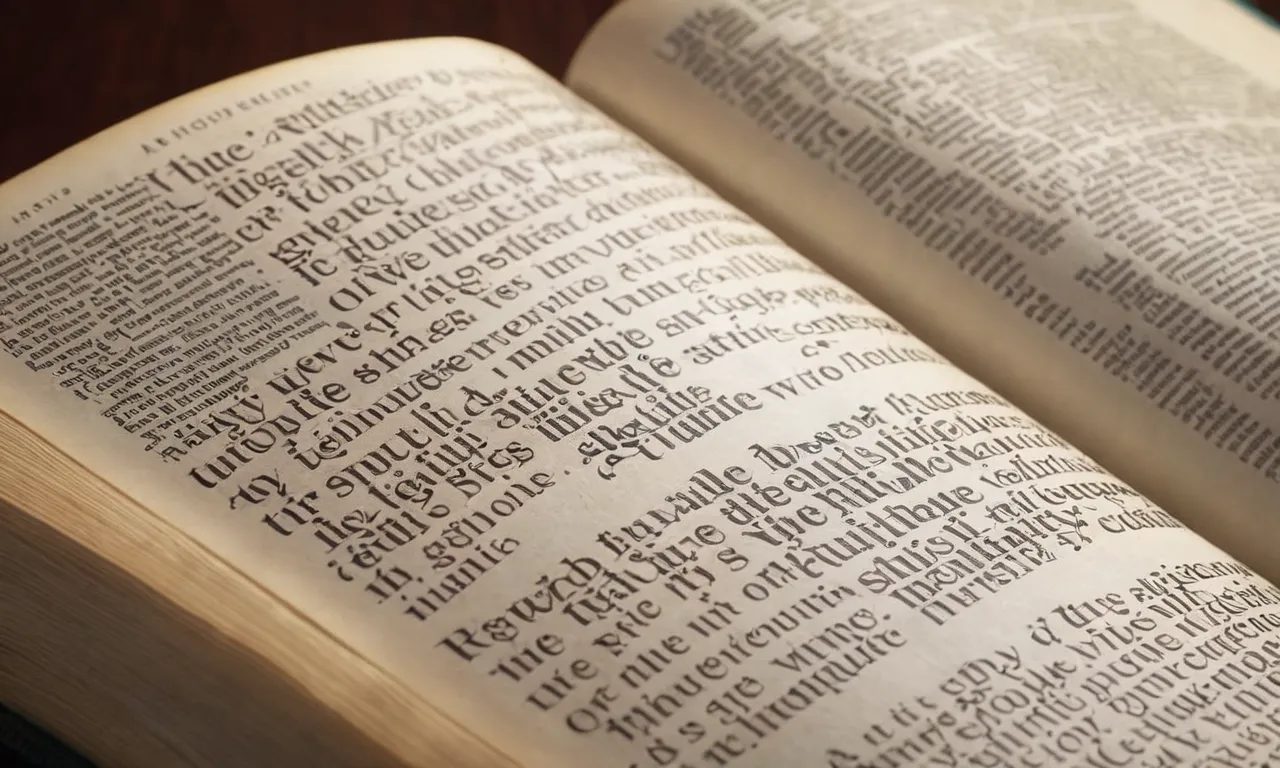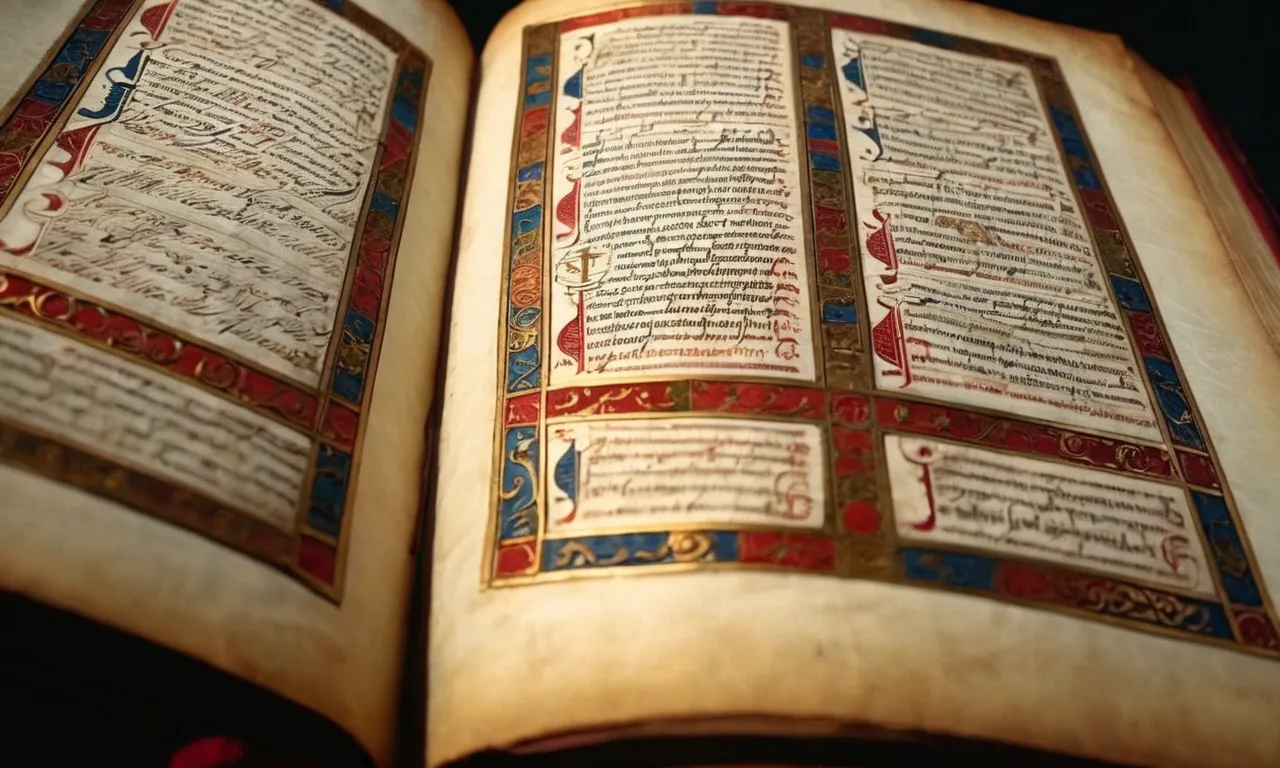What Was The Bible Before The King James Version?
The Bible is one of the most influential books in history, but did you know that the King James Version was not the original Bible?
For centuries before 1611 when the King James Bible was published, there were several key translations and versions of the scriptures in circulation.
If you’re short on time, here’s a quick answer to your question: Before the King James Version, the Latin Vulgate and John Wycliffe’s Bible were two major versions that Christians widely used in Europe. The original biblical texts were written in Hebrew, Aramaic, and Greek.
In this comprehensive guide, we will dive deep into the origins of the Bible and walk through the various translations and versions that existed before the King James Version became the dominant English translation.
The Original Biblical Languages
Hebrew and Aramaic
The Old Testament was originally written mostly in Biblical Hebrew, with some passages in Biblical Aramaic.
Biblical Hebrew dates back over 3,000 years and was used by the ancient Israelites. It fell out of common use around 400 BCE when Aramaic became the primary language in the region.
However, Hebrew continued to be used as a liturgical and literary language. The oldest surviving Hebrew Bible manuscripts date to the Dead Sea Scrolls from around 200 BCE to 70 CE.
Koine Greek
The New Testament was written in Koine Greek, which was the common language in the eastern Mediterranean region after the conquests of Alexander the Great in the 4th century BCE.
It was originally the dialect used in Athens which then spread throughout Greece and beyond.
Koine means “common” in Greek. The majority of existing New Testament manuscripts date from between the 2nd to 15th centuries, with the oldest fragment dating around 125 CE.
The Septuagint
The Septuagint refers to the Koine Greek translations of the Hebrew scriptures completed in Alexandria, Egypt around 200 BCE.
Though there are debates about the exact origins of the Septuagint, it gained widespread use by Jews outside of Israel. It is also the version most often quoted in the New Testament when referring to the Old Testament writings.
Early Translations of the Bible
Old Latin Versions
The earliest translations of the Bible were into Latin. These early Latin translations were completed between the 2nd and 5th centuries AD and are collectively known as the Vetus Latina or “Old Latin” versions.
They originated from the Jewish diaspora and Christian missionaries translating the Greek Septuagint and Greek New Testament into Latin for Latin-speaking Christian communities.
The Vetus Latina versions continued to be copied and used alongside the later Vulgate Bible for several centuries. However, being translations of translations, the Vetus Latina versions became increasingly corrupted and unreliable.
By the 13th century, the Vulgate had largely replaced the Vetus Latina versions, being declared the official Latin Bible of the Catholic Church by the Council of Trent in 1546.
Jerome’s Latin Vulgate
The Vulgate is the most famous Latin translation of the Bible. It was created in the late 4th century AD by the Christian scholar Jerome.
He translated most of the Old Testament from Hebrew sources rather than from the Greek Septuagint. For the New Testament, Jerome translated from Greek manuscripts available at the time.
Jerome’s fresh translations from the original Hebrew and Greek helped make the Vulgate far more accurate than the Old Latin translations.
The Vulgate remained the standard version of the Bible for over 1,000 years and had a major influence on Western Christianity.
It also contributed greatly to the development of Ecclesiastical Latin.
Other Early Translations
In addition to Latin versions, the Bible was translated into other languages in ancient times. These included:
- The Gothic Bible – Partial translation of the New Testament into the Gothic language by the Visigothic bishop Ulfilas around 350 AD.
- The Vetus Syra (Old Syriac) – Translations of the Gospels into Syriac from the Greek, dating to the 3rd/4th centuries.
- The Armenian Bible – Armenian translation traditionally attributed to the 5th century missionary Mesrop Mashtots.
- The Georgian Bible – Georgian translation, tentatively dated to the 5th century.
- The Coptic Versions – A number of incomplete translations into Coptic dialects from the 3rd to 4th centuries.
Although not as well-known or influential as the major Latin, Greek and Hebrew versions, these early translations are still important for textual criticism and preserving early biblical manuscripts.

John Wycliffe and the Wycliffe Bible
John Wycliffe was an influential theologian and professor at Oxford University in the 14th century. He was a pivotal figure in the pre-Reformation movement and is often called the “Morning Star of the Reformation.”
Wycliffe believed that the Bible should be available to all people in their common language, rather than restricted to Latin Vulgate translations that could only be read by the clergy and educated elite.
To that end, Wycliffe supervised a project to translate the Vulgate into English around 1380-1382. This was the first complete translation of the Bible into English and was hugely controversial at the time.
The Catholic Church condemned Wycliffe’s translation and declared it heretical in 1408, but copies continued to circulate in England among Wycliffe’s followers known as Lollards.
Wycliffe’s Bible predated the invention of the printing press, so each copy had to be handwritten. Over 200 manuscript copies from the 14th and 15th centuries still survive today. The translation style was designed to be accessible to laypeople, using common language rather than academic phrasing.
It relied heavily on the Vulgate text but showed some influence from earlier Anglo-Norman Bible translations.
Some key facts about the Wycliffe Bible:
- It was the first complete English translation, including both the Old and New Testaments.
- The translators were led by John Wycliffe and possibly Nicholas Hereford, a contemporary Oxford scholar.
- The earliest manuscripts date from the 1380s, with revisions continuing through the 15th century.
- It helped to establish English as a literary language at a time when Latin and French dominated educated circles.
- The Church declared it illegal to own or read Wycliffe’s translation without approval.
- Jan Hus, the great Czech reformer, helped to promote the Wycliffe Bible in Bohemia.
Although later English Bible translations like Tyndale’s and the KJV superseded it, Wycliffe’s pioneering work laid the foundation for centuries of Bible translation to follow.
The accessibility and popularity of his English Bible threatened Church control and shifted religious authority to the text itself rather than ecclesiastical interpretation.
This revolutionary idea spread rapidly through pre-Reformation popular religious movements, paving the way for later Reformers.
William Tyndale’s Translation
William Tyndale was a scholar and priest in the early 1500s who believed that the Bible should be available to everyone in their native language. At a time when the Bible was only published in Latin, Tyndale’s vision was controversial.
He set out on a mission to translate the New Testament from Greek and parts of the Old Testament from Hebrew into English.
This was no easy feat; translating the Bible into another language outside of Latin was seen as defying the Catholic church, not to mention translating from ancient Hebrew and Greek was an enormous scholarly challenge.
However, Tyndale was undeterred.
He was fluent in eight languages and was a gifted translator, creating an English text that flowed beautifully while still remaining faithful to the original languages.
His translation introduced new words and phrases into the English language that became staples, like “Jehovah” for God and “scapegoat.” Though authorities opposed and eventually executed Tyndale for his work, his legacy lived on.
His translations would go on to heavily influence future English versions—especially the King James translation.
Tyndale’s New Testament translation was completed while in hiding in Cologne, Germany in 1525. It drew largely from the third edition of Erasmus’s Greek New Testament, as well as Luther’s German Bible and the Latin Vulgate.
Unlike most previous English translations, Tyndale worked directly from Greek, Hebrew and Aramaic sources rather than just Latin translations. He was the first to translate large parts of the Old Testament from Hebrew sources.
His translation aimed for readability and accessibility for average people.
Tyndale used vivid, down-to-earth Early Modern English. For example, he translated metanoeite as “repent” instead of the Latin-derived “do penance.” His goal was for plowboys to be as familiar with scripture as learned religious leaders.
His word choices challenged traditional church teachings in subtle linguistic ways. While risky, it made the Bible easier for laypeople to read themselves.
The Geneva and Bishops’ Bibles
The Geneva Bible and the Bishops’ Bible were two influential English Bible translations that preceded the King James Version (KJV).
The Geneva Bible
The Geneva Bible was first published in 1560 by Protestant exiles who fled persecution under Queen Mary I’s Catholic reign. It quickly became the most popular translation in Elizabethan England.
The Geneva Bible contained many innovative features, including verse numbers, italics to indicate translated words, cross references, and extensive commentary notes on passages and verses.
Its portable size also made it quite accessible. Over 150 editions of the Geneva Bible were issued, more than any other English Bible translation up until that time.
The Geneva Bible was the Bible of choice for many English readers and was the Bible brought to America by the Pilgrims and Puritans.
Famous figures who read and studied the Geneva Bible include William Shakespeare, John Knox, John Donne, and John Bunyan.
Its influence on the King James Version cannot be overstated.
The Bishops’ Bible
The Bishops’ Bible, first published in 1568, was authorized by the Church of England as an alternative to the Geneva Bible, though it failed to gain much popularity. There were over 20 editions printed, yet its cost prohibited wide distribution.
Queen Elizabeth I and Archbishop Matthew Parker directed the bishops of the Church of England to produce this new version under the Great Bible version of the scriptures.
Unlike the Geneva Bible, the Bishops’ Bible contained no commentary notes to avoid any perception of Calvinist influence. Its translations were more literal and traditional.
But many critics complained the Bishops’ Bible was too cumbersome in style.
Also, the quality and accuracy of the translations were uneven since the different Biblical books were divided among the bishops to work on. Still, it did serve as the base text for the committees that would later undertake the King James Version.
Conclusion
For well over a millennium before the King James Version appeared in 1611, numerous translations and versions of the scriptures circulated among Christians in Europe and beyond.
Key milestones included Jerome’s Latin Vulgate in the 4th century AD, John Wycliffe’s 14th century English translation, William Tyndale’s 16th century English New Testament, and the Geneva and Bishops’ Bibles just before the KJV.
While the King James Version became preeminent and changed the course of Bible translation, it stood on the shoulders of the many translations that came before it.








